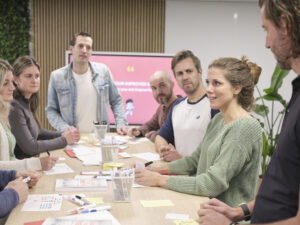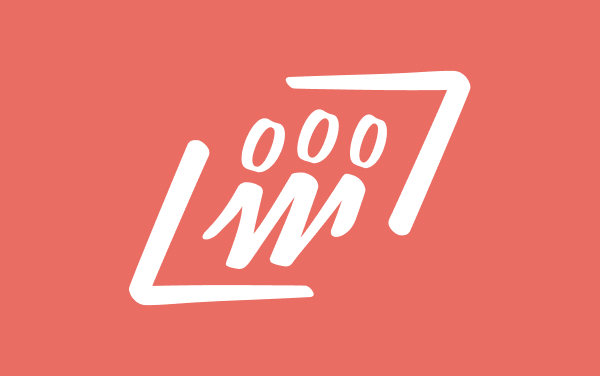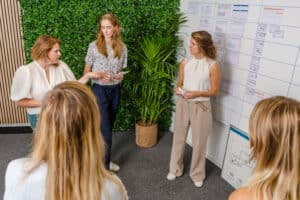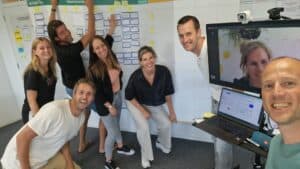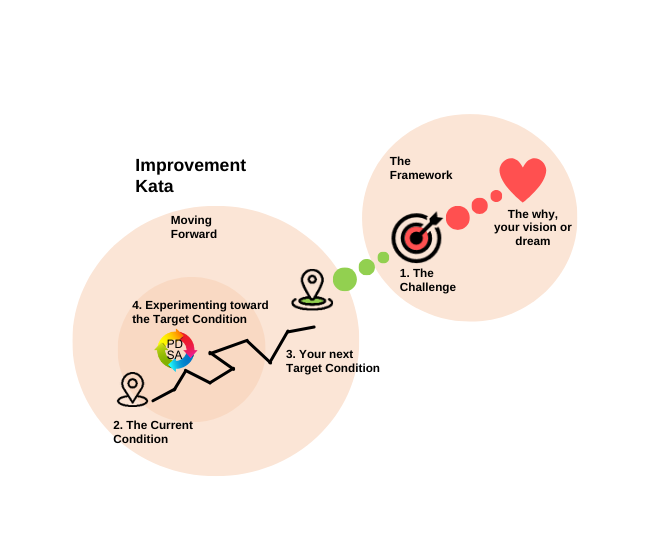
Kata in Obeya shows how to speed up learning and decisions making. In the Obeya (“big room”), you connect the Improvement Kata and Coaching Kata to strategy. Small experiments, clear expectations, and PDCA build a learning culture—and results that stick. Read on to see where to start today.
Why kata in your Obeya?
Kata consists of two routines: the improvement routine and the routine of coaching it. In the Obeya (Japanese for “big room”), there are countless opportunities to apply both. Why would you want to do this? The more often you practice the routine, the more it becomes ingrained—and the more likely it will be used outside the Obeya. Once that happens, you are truly shifting your organization’s culture toward a learning culture, and continuous improvement becomes part of your people’s DNA.

How can you get started?
In the Obeya, you’ll find the [Difficult Problems] section. In this part of the Obeya, you discuss challenges for which you don’t yet know the path to a good outcome. The kata routines help you progress—experimenting step by step—toward the desired result. More importantly, by using the fixed set of kata questions, you learn to repeatedly cycle through Plan-Do-Study-Act. You develop a meta-skill that enables you to move forward with resilience in situations of uncertainty.
And how does that work in the rest of the Obeya?
- In the [Act and React] section, you discuss the day-to-day issues together and place the committed actions on the board. What would happen if you also note an expectation for each action, so you can discuss the next day how it went and what you can learn from it? A small kata moment, every day.
- On the [Plan to Value] board, you have essentially projected an expectation: a series of activities laid out over time that you expect will lead to a certain outcome. You can see these as interim target conditions on the way to specific results in terms of KPIs. Every result delivered by a project component is another intermediate step. Reflect using Kata when such a component or step is finished. Or when unforeseen events occur, or when there are deviations from the plan. Ask yourself: what can we learn from this? At the project level, and also more generally about how we run projects.
- In the [Performance] section, you visualize objectives and data. There are hypotheses embedded here, such as: if we carry out the planned projects, we expect movement in this KPI or OKR. If the data turns out differently than expected, what can you learn about the actions you took—and what now seems wise to do?
- On the [Strategic Direction] board, you have laid the foundation for everything else on the Obeya wall: the ultimate challenge. You have also made assumptions here—for example, which strategic capabilities will have the greatest impact on achieving the bigger goal. The Kata reflection questions are a helpful guide for reviewing—and, if needed, revising—these assumptions.
Practice, practice, practice
You’ll quickly notice that kata routines require a lot of practice. So create as many practice moments for yourself as possible and use your Obeya as a place to practice and learn. Bring in a second coach so the kata coach also has the opportunity to learn to excel at asking the kata questions.
Lead a learning organization: master Toyota Kata and coaching leadership.
Book your Toyota Kata training
Auteurs: Elske Heeren en Mariëlle Zwaga
Elske and Mariëlle are working on their dream: helping others develop their kata coaching skills. These kata coaches can contribute to making other people’s dreams a reality—both at work and in life. Elske and Mariëlle do this through KataKanjers and in close collaboration with Leading with Obeya. They offer training and coaching for individuals and organizations to help you get started.

